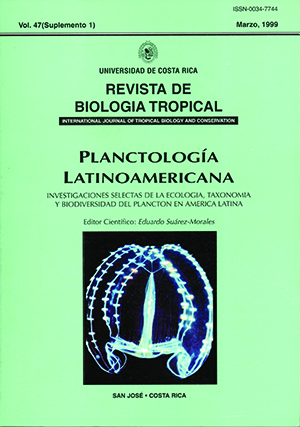Abstract
A total of 31 phytoplankton samples collected during January-December 1997 from Mazatlán Bay, Sinaloa, Mexico, were analized in order to study the red tide dynamics caused by the dinoflagellate Gymnodinium catenutum as well as determining the degree of toxicity thal it could transmit to local oyster products, Phytoplankton samples were quantified using the Uttermohl method, The toxicological analysis were made on oysters (Ostrea iridescens) to detect the PSP (Paralytic Shelfish Poisoning) toxin, by mouse bioassay method. The results showed cases of red tide caused by G. catenatum in April and Oktober, with cell concentralions of 5 000 and 3 873 cells ml-1, respectively. This was the dominant species in the phytoplanklon community with a relative abundance of 99 %. The PSP toxin concentrations were lower than 35 µg 100g-1, which were within the maximum permissible limit (80 µg 100g-1) to avoid health risksin shellfish consumption. The low toxin concentration in oysters compared with a high cell density, could be due to the fact that the denser spots of red tides were far from the oysters beds. This study provides the first. G. catenatum toxin concentration report in Mazatlán Bay.
References
Anónimo. 1990. Paralytic Shellfish Poison. Biological Method, pp. 881-882. In. Official Methods of Analysis of the Association of Official Agricultural Chemist Intemational, P. Cunnif (ed.). Arlington, Virginia.
Cortés-Altamirano, R.; F.A. Manrique & R. Luna-Soria. 1995a. Presencia de mareas rojas en la costa este del Golfo de California. Rev. Lat.-Amer. Microbiol.
:337-342.
Cortés-Altamirano, R., D. V. Hernández-Becerril & R. Luna-Soria. 1995b. Mareas Rojas en México, una Revisión. Rev. Lat. Amer. Microbiol. 37: 343-352.
Cortés-Altamirano R. & R. Alonso Rodríguez. 1997. Mareas rojas durante 1997 en la bahía de Mazatlán Sinaloa, México. Ciencias del Mar UAS 15:29-35.
Graham, H. W. 1943. Gymnodinium catenatum, a new dinoflagellate from the Gulf of California. Trans. Am. Microscop. Soc. 62: 259-261.
Hasle, G.R. 1978. Using the inverted microscope, pp. 191-196. In: Phytoplankton manual, UNESCO, A. Sournia (ed.). Paris, Francia.
Mee, L. D., M. Espinoza & G. Diaz. 1986. Paralytic Shellfish Poisoning with Gymnodinium catenatum red tide on the Pacific coast of Mexico. Marine Environmental Research 19:77-92.
Comments

This work is licensed under a Creative Commons Attribution 4.0 International License.
Copyright (c) 1999 Revista de Biología Tropical


